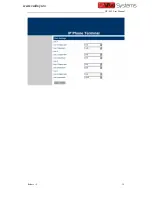
Release 1.2
28
1.
Signaling Port
– This Port is used to convey signaling message with the SIP
Proxy. The standard port number is 5060.
2.
NAT Keep-alive
– When enabled, a dummy packet I sent to the local firewall /
router in order to keep the ports opened for VoIP service.
3.
P2P
– This enables Peer-to-Peer calls.
4.
Virtual Ringback
– This enables a ringback tone to be generated whenever a call
is made.
5.
DTMF Signaling
– This parameter sets the method of sending DTMF signals.
Inband
measns that the DTMF signal is sent as an analog signal via the voice
channel.
Outband
means that the DTMF signal is sent as DTMF command via
the data channel. Both
RFC2833
and
SIP INFO
methods are supported. For
RFC2833,
a DTMF payload type is required and the default type is set to 101.
6.
Signaling QoS
– This parameter sets the QoS mode for VoIP Signaling for better
response time and more reliable VoIP Call signaling. Both IP TOS and Diffserv
modes are supported. Please check with your network administrator or ISP for
the correct setting.
7.
Signaling Encryption
– Five types of encryption methods are supported and
these are used by various network equipment vendors in China to avoid blocking
of SIP signaling traffics. Please consult your SIP service provided to determine
which encryption method is supported.
a)
RC4
– RC4 Encryption Key is required when it is enabled.
b)
Fast
–
c)
VOS
– This encryption is developed by a network equipment vendor in
Nanjing, China.
www.vaidsys.ru
HT-842 User Manual












































